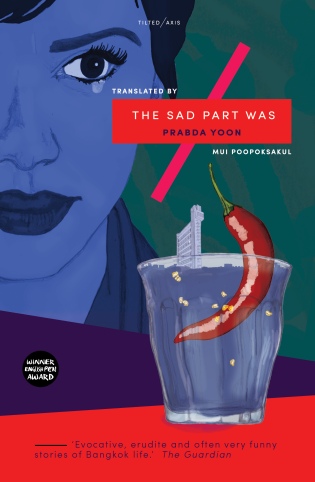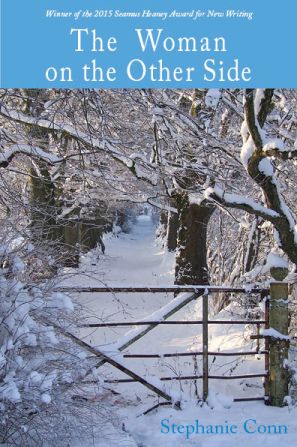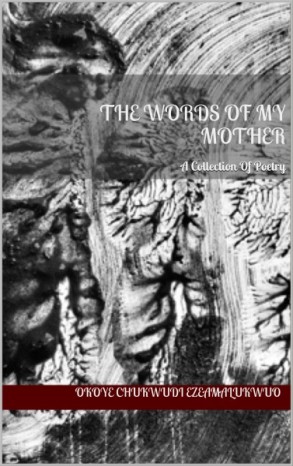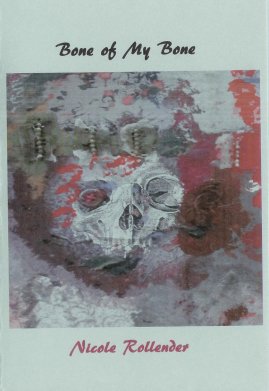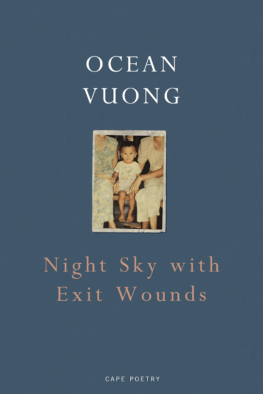
Editor’s Note: Vuong was awarded the Felix Dennis Prize for Best First Collection at the Forward Prize 2017
In living with Ocean Vuong’s book over the last week or two I have on occasions mistaken its title for Night Sky with Exile Wounds. It will become obvious why. But it has also been hard to ‘see’ this collection because of the accumulated material – interviews, awards, perhaps hype – that already surrounds it in a way that affects none of the other Forward First Collections this year. Vuong has already appeared on the cover of Poetry London and been interviewed by The New Yorker. He has been nominated as one of Foreign Policy magazine’s 100 Leading Global Thinkers. Such recognition is even more extraordinary given that Vinh Quoc Vuong was born in 1988 on a rice farm outside Saigon and, at the age of two, he and six relatives emigrated to Hartford, Connecticut, where they lived together in a one-bedroom apartment. On learning that ‘ocean’ (in American English) is a body of water that touches many countries – including Vietnam and the United States – his mother renamed her son.
Ocean Vuong is also gay. Hence his exile – the word that kept coming into my mind – is one not only from his birth country and culture but also from the mainstreams of his adopted country. It’s no surprise there are several Ocean Vuongs in this book in terms of subject matter as well as in its use of a variety of poetic forms. This might – reflecting his given name – be an essential, protean, shape-shifting style or it might reveal the kind of casting around in the sea of form and content one might expect from a first collection. I think it is more the latter than the former, though the thrashing and contortion involved in such self creation (we used to refer to ‘self discovery’ – the book title has ‘self portrait’) is now a topic of such ubiquity in Western culture that Vuong’s personal struggles may come to be considered as representative in themselves.
Though 13 years before his birth, ‘Aubade with Burning City’ portrays the American withdrawal from Saigon in 1975. Apparently, Armed Forces Radio played ‘White Christmas’ as a sign to commence the withdrawal and the poem assembles a montage of the song lyric, events on the streets of Saigon and a sinister, coercive-sounding male/female dialogue. The result reflects the chaos of such a moment of violent transition (though the ironies of the sentimental song are a bit obvious) and introduces a recurrent thread in Vuong’s work, the uneasy alliance between power and sex. ‘A Little Closer to the Edge’ seems a reminiscence, perhaps of his own conception (Cape’s cover image of the young poet encourages this biographical approach). Among bomb craters and anticipated domestic violence, a young Vietnamese couple are at first “hand in hand”. Then:
He lifts her white cotton skirt, revealing
another hour. His hand. His hands. The syllables
inside them. O father, O foreshadow, press
into her –
For his mother’s part, the narrative voice asks her to show “how ruin makes a home / out of hip bones” and also to “teach me / how to hold a man”.
Once in the USA, there are poems that treat both parents with some tenderness. In ‘The Gift’, the son teaches his mother the alphabet. She can hardly get beyond the third letter, the fourth, gone astray, appearing only as
a strand of black hair – unravelled
from the alphabet
& written
on her cheek
Several portrayals of Vuong’s father suggest violence and drinking but in ‘In Newport I Watch my Father Lay his Cheek to a Beached Dolphin’s Wet Back’ he is seen to express concern for the creature, “the wet refugee”, though the poem is fractured by bullets, Huey helicopters, shrapnel and snipers as if to suggest the root of the father’s violence and his inability to express affection for his own family.
Or perhaps such things innate to a man? Another major theme in the book is masculinity itself as expressed through father figures and a young gay man growing up. The former is seen in two poems involving guns. ‘The Smallest Measure’ has the father instructing the boy on how to handle a Winchester rifle (it reminds me of a photograph of Hemingway and his son). ‘Always and Forever’ (Vuong’s note tells us this is his father’s favourite Luther Vandross song) has the father substituting himself with a Colt.45 in a shoe box: “Open this when you need me most”, he says. The boy seems to wonder if the gun might deliver a liberation of sorts: “[I] wonder if an entry wound in the night // would make a hole wide as morning”. This image of an aperture being made in darkness – most often through an act of violence – to let in light recurs in these poems. I can’t quite see what is intended here but there are again links to the erotic/violence motif. Later, the gun barrel must “tighten” around the bullet “to make it speak”, making further obscure, but interesting, links to violence and the ability to speak (or write).

What it is to be a (young, gay) man is explored in the second part of the collection. Andrew McMillan’s physical comes to mind in reading these poems (McMillan interviewed Vuong for Poetry London recently). ‘Because It’s Summer’ is a more conventionally lineated poem in the second person singular (some distancing there) of slipping away from a mother’s control (and expectations) to meet a boy “waiting / in the baseball field behind the dugout”. It’s particularly good at conveying the exciement (on both sides) of a desire, previously played out alone, being mutually gratified: “the boy [. . .] finds you / beautiful because you’re not / a mirror”. ‘Homewrecker’ evokes the energy of erotic discovery as well as the ‘wreckage’ it threatens (to some) in the “father’s tantrum” as much as the “mothers’ / white dresses spilling from our feet”. ‘Seventh Circle of Earth’ is particularly inventive in its form. The poem – set as prose, but with line break slashes included (a baggy, hybrid form Vuong uses elsewhere) – appears as a series of footnotes. The footnote numbers appear scattered across a blank page. The poem deals with the murder, by immolation, of two gay men in Dallas in 2011. The mainstream silence is cleverly played against the passionate love poem only recorded as footnotes.
Elsewhere, Vuong hits less successful notes and styles. There are some dream poems – like ‘Queen under the Hill’ – which don’t always escape the hermetic seal around an individual’s dream world. On other occasions, he wants to use mythic stories to scaffold his own. ‘Telemachus’ is probably the most successful of these (the materials again feeling dream-like to me) as the son pulls his dead (shot dead) father from the ocean. Elsewhere we find allusions to Orpheus and Eurydice (and to Lorca’s ‘Sleepwalking Ballad’ and Rilke’s ‘Archaic Torso of Apollo’). Certainly, Vuong is not fearful of taking on big subjects such as JFK’s assassination (‘Of Thee I Sing’), the murders of Jeffrey Dahmer (‘Into the Breach’) and 9/11 (‘Untitled’).
But actually I think ‘ordinariness’ and those poems which show the influence of O’Hara and the New York School prove a more fertile direction. In an interview, Vuong has discussed the Rilkean imperative to look, what the young poet calls the “inexhaustibility in gazing”, something with which we might “resist the capitalist mythos of an expendable gaze”. So ‘On Earth We Are Briefly Gorgeous’ (I do hope Vuong thinks, as I do, of Jay Gatsby whenever he uses that last word) the fragments of vivid perception amount to more than the sum of its parts. ‘Notebook Fragments’ – which appears to be precisely what the title says – works better than some more crafted poems in the collection. And ‘Devotion’ – with its concluding placement suggesting Vuong knows how good it is – rises out of the sometimes conflicting biographical currents that by his own admission have buffeted him. It’s a beautiful lyric (the form, tripping, delicate, this time not drawing attention to itself) about oral sex; its debatable claims made with utter conviction:
there’s nothing
more holy than holding
a man’s heartbeat between
your teeth, sharpened
with too much
air
The lilting lineation, the brush-strokes of punctuation, work better here than in some of Vuong’s more Whitman-esque streamings of consciousness. The enviable, insouciance of youth – “& so what” – is thrillingly conveyed. Yet, it turns out, this is not really about the provocative challenges of a variety of states of exile and ‘otherness’, but about the need to feel anything “fully”, however transient it may prove to be:
Only to feel
this fully, this
entire, the way snow
touches bare skin – & is,
suddenly, snow
no longer.
______________________________________________________________________
Martyn Crucefix’s recent books include The Time We Turned (Shearsman, 2014), A Hatfield Mass (Worple Press, 2014) and Daodejing – a new version in English (Enitharmon, 2016. Just published is The Lovely Disciplines (Seren, 2017) and forthcoming are limited editions of O. at the Edge of the Gorge(Guillemot Press, 2017) and A Convoy (If a Leaf Falls Press, 2017)
This article is republished with permission of the author. To find more of his reviews, click here: Martyn Crucefix
